Impact of residual disease as a prognostic factor for survival in women with advanced epithelial ovarian cancer after primary surgery
- PMID: 36161421
- PMCID: PMC9512080
- DOI: 10.1002/14651858.CD015048.pub2
Impact of residual disease as a prognostic factor for survival in women with advanced epithelial ovarian cancer after primary surgery
Abstract
Background: Ovarian cancer is the seventh most common cancer among women and a leading cause of death from gynaecological malignancies. Epithelial ovarian cancer is the most common type, accounting for around 90% of all ovarian cancers. This specific type of ovarian cancer starts in the surface layer covering the ovary or lining of the fallopian tube. Surgery is performed either before chemotherapy (upfront or primary debulking surgery (PDS)) or in the middle of a course of treatment with chemotherapy (neoadjuvant chemotherapy (NACT) and interval debulking surgery (IDS)), with the aim of removing all visible tumour and achieving no macroscopic residual disease (NMRD). The aim of this review is to investigate the prognostic impact of size of residual disease nodules (RD) in women who received upfront or interval cytoreductive surgery for advanced (stage III and IV) epithelial ovarian cancer (EOC).
Objectives: To assess the prognostic impact of residual disease after primary surgery on survival outcomes for advanced (stage III and IV) epithelial ovarian cancer. In separate analyses, primary surgery included both upfront primary debulking surgery (PDS) followed by adjuvant chemotherapy and neoadjuvant chemotherapy followed by interval debulking surgery (IDS). Each residual disease threshold is considered as a separate prognostic factor.
Search methods: We searched CENTRAL (2021, Issue 8), MEDLINE via Ovid (to 30 August 2021) and Embase via Ovid (to 30 August 2021).
Selection criteria: We included survival data from studies of at least 100 women with advanced EOC after primary surgery. Residual disease was assessed as a prognostic factor in multivariate prognostic models. We excluded studies that reported fewer than 100 women, women with concurrent malignancies or studies that only reported unadjusted results. Women were included into two distinct groups: those who received PDS followed by platinum-based chemotherapy and those who received IDS, analysed separately. We included studies that reported all RD thresholds after surgery, but the main thresholds of interest were microscopic RD (labelled NMRD), RD 0.1 cm to 1 cm (small-volume residual disease (SVRD)) and RD > 1 cm (large-volume residual disease (LVRD)).
Data collection and analysis: Two review authors independently abstracted data and assessed risk of bias. Where possible, we synthesised the data in meta-analysis. To assess the adequacy of adjustment factors used in multivariate Cox models, we used the 'adjustment for other prognostic factors' and 'statistical analysis and reporting' domains of the quality in prognosis studies (QUIPS) tool. We also made judgements about the certainty of the evidence for each outcome in the main comparisons, using GRADE. We examined differences between FIGO stages III and IV for different thresholds of RD after primary surgery. We considered factors such as age, grade, length of follow-up, type and experience of surgeon, and type of surgery in the interpretation of any heterogeneity. We also performed sensitivity analyses that distinguished between studies that included NMRD in RD categories of < 1 cm and those that did not. This was applicable to comparisons involving RD < 1 cm with the exception of RD < 1 cm versus NMRD. We evaluated women undergoing PDS and IDS in separate analyses.
Main results: We found 46 studies reporting multivariate prognostic analyses, including RD as a prognostic factor, which met our inclusion criteria: 22,376 women who underwent PDS and 3697 who underwent IDS, all with varying levels of RD. While we identified a range of different RD thresholds, we mainly report on comparisons that are the focus of a key area of clinical uncertainty (involving NMRD, SVRD and LVRD). The comparison involving any visible disease (RD > 0 cm) and NMRD was also important. SVRD versus NMRD in a PDS setting In PDS studies, most showed an increased risk of death in all RD groups when those with macroscopic RD (MRD) were compared to NMRD. Women who had SVRD after PDS had more than twice the risk of death compared to women with NMRD (hazard ratio (HR) 2.03, 95% confidence interval (CI) 1.80 to 2.29; I2 = 50%; 17 studies; 9404 participants; moderate-certainty). The analysis of progression-free survival found that women who had SVRD after PDS had nearly twice the risk of death compared to women with NMRD (HR 1.88, 95% CI 1.63 to 2.16; I2 = 63%; 10 studies; 6596 participants; moderate-certainty). LVRD versus SVRD in a PDS setting When we compared LVRD versus SVRD following surgery, the estimates were attenuated compared to NMRD comparisons. All analyses showed an overall survival benefit in women who had RD < 1 cm after surgery (HR 1.22, 95% CI 1.13 to 1.32; I2 = 0%; 5 studies; 6000 participants; moderate-certainty). The results were robust to analyses of progression-free survival. SVRD and LVRD versus NMRD in an IDS setting The one study that defined the categories as NMRD, SVRD and LVRD showed that women who had SVRD and LVRD after IDS had more than twice the risk of death compared to women who had NMRD (HR 2.09, 95% CI 1.20 to 3.66; 310 participants; I2 = 56%, and HR 2.23, 95% CI 1.49 to 3.34; 343 participants; I2 = 35%; very low-certainty, for SVRD versus NMRD and LVRD versus NMRD, respectively). LVRD versus SVRD + NMRD in an IDS setting Meta-analysis found that women who had LVRD had a greater risk of death and disease progression compared to women who had either SVRD or NMRD (HR 1.60, 95% CI 1.21 to 2.11; 6 studies; 1572 participants; I2 = 58% for overall survival and HR 1.76, 95% CI 1.23 to 2.52; 1145 participants; I2 = 60% for progression-free survival; very low-certainty). However, this result is biased as in all but one study it was not possible to distinguish NMRD within the < 1 cm thresholds. Only one study separated NMRD from SVRD; all others included NMRD in the SVRD group, which may create bias when comparing with LVRD, making interpretation challenging. MRD versus NMRD in an IDS setting Women who had any amount of MRD after IDS had more than twice the risk of death compared to women with NMRD (HR 2.11, 95% CI 1.35 to 3.29, I2 = 81%; 906 participants; very low-certainty).
Authors' conclusions: In a PDS setting, there is moderate-certainty evidence that the amount of RD after primary surgery is a prognostic factor for overall and progression-free survival in women with advanced ovarian cancer. We separated our analysis into three distinct categories for the survival outcome including NMRD, SVRD and LVRD. After IDS, there may be only two categories required, although this is based on very low-certainty evidence, as all but one study included NMRD in the SVRD category. The one study that separated NMRD from SVRD showed no improved survival outcome in the SVRD category, compared to LVRD. Further low-certainty evidence also supported restricting to two categories, where women who had any amount of MRD after IDS had a significantly greater risk of death compared to women with NMRD. Therefore, the evidence presented in this review cannot conclude that using three categories applies in an IDS setting (very low-certainty evidence), as was supported for PDS (which has convincing moderate-certainty evidence).
Copyright © 2022 The Cochrane Collaboration. Published by John Wiley & Sons, Ltd.
Conflict of interest statement
Andrew Bryant: none known
Ahmed Elattar: none known
Patience Kunonga: none known
Brett A Winter‐Roach: none known
Shaun Hiu: none known
Dawn Craig: none known
Luke Vale: none known
Ketankumar Gajjar: none known
Raj Naik: none known
Figures

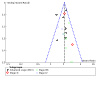


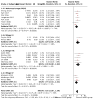
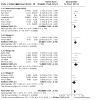
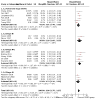
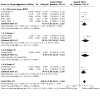
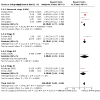
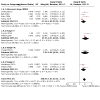
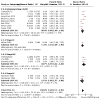

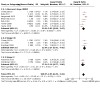
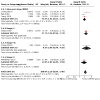
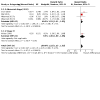
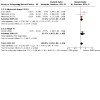
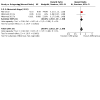
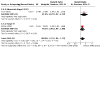
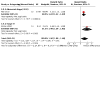

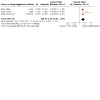








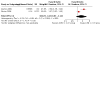

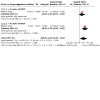
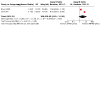

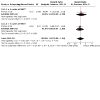
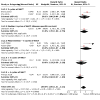
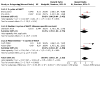
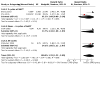
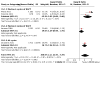
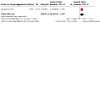
Update of
References
References to studies included in this review
Akahira 2001 {published data only}
-
- Akahira JI, Yoshikawa H, Shimizu Y, Tsunematsu R, Hirakawa T, Kuramoto H. Prognostic factors of stage IV epithelial ovarian cancer: a multicenter retrospective study. Gynecologic Oncology 2001;81(3):398-403. - PubMed
Aletti 2006 {published data only}
-
- Aletti GD, Dowdy SC, Gostout BS, Jones MB, Stanhope CR, Wilson TO, et al. Aggressive surgical effort and improved survival in advanced-stage ovarian cancer. Obstetrics and Gynecology 2006;107:77–85. - PubMed
-
- Aletti GD, Dowdy SC, Podratz KC, Cliby WA. Relationship among surgical complexity, short-term morbidity, and overall survival in primary surgery for advanced ovarian cancer. American Journal of Obstetrics and Gynecology 2007;197(6):1-7. - PubMed
-
- Aletti GD, Dowdy SC, Podratz KC, Cliby WA. Surgical treatment of diaphragm disease correlates with improved survival in optimally debulked advanced stage ovarian cancer. Gynecologic Oncology 2006;100(2):283-7. - PubMed
-
- Aletti GD, Podratz KC, Jones MB, Cliby WA. Role of rectosigmoidectomy and stripping of pelvic peritoneum in outcomes of patients with advanced ovarian cancer. Journal of the American College of Surgeons 2006;203(4):521-6. - PubMed
Ataseven 2016 {published data only}
-
- Ataseven B, Grimm C, Harter P, Heitz F, Traut A, Prader S, et al. Prognostic impact of debulking surgery and residual tumor in patients with epithelial ovarian cancer FIGO stage IV. Gynecologic Oncology 2016;140(2):215-20. - PubMed
Bixel 2020 {published data only}
-
- Bixel K, Vetter M, Davidson B, Berchuck A, Cohn D, Copeland L, et al. Intraperitoneal chemotherapy following neoadjuvant chemotherapy and optimal interval tumor reductive surgery for advanced ovarian cancer. Gynecologic Oncology 2020;156:530–4. - PubMed
Bristow 2011 {published data only}
-
- Bristow RE, Ueda S, Gerardi MA, Ajiboye OB, Ibeanu OA. Analysis of racial disparities in stage IIIC epithelial ovarian cancer care and outcomes in a tertiary gynecologic oncology referral center. Gynecologic Oncology 2011;122(2):319-23. - PubMed
Chan 2003 {published data only}
-
- Chan JK, Loizzi V, Lin YG, Osann K, Brewster WR, DiSaia PJ. Stages III and IV invasive epithelial ovarian carcinoma in younger versus older women: what prognostic factors are important? Obstetrics and Gynecology 2003;102(1):156-61. - PubMed
Chang 2012a {published data only}
-
- Chang SJ, Bristow RE, Ryu HS. Impact of complete cytoreduction leaving no gross residual disease associated with radical cytoreductive surgical procedures on survival in advanced ovarian cancer. Annals of Surgical Oncology 2012;19(13):4059-67. - PubMed
Chang 2012b {published data only}
-
- Chang SJ, Bristow RE, Ryu HS. Prognostic significance of systematic lymphadenectomy as part of primary debulking surgery in patients with advanced ovarian cancer. Gynecologic Oncology 2012;126(3):381-6. - PubMed
Chi 2001 {published data only}
-
- Chi DS, Liao JB, Leon LF, Venkatraman ES, Hensley ML, Bhaskaran D, et al. Identification of prognostic factors in advanced epithelial ovarian carcinoma. Gynecologic Oncology 2001;82(3):532-7. - PubMed
Chi 2006 {published data only}
-
- Chi DS, Eisenhauer EL, Lang J, Huh J, Haddad L, Abu-Rustum NR, et al. What is the optimal goal of primary cytoreductive surgery for bulky stage IIIC epithelial ovarian carcinoma (EOC)? Gynecologic Oncology 2006;103:559–64. - PubMed
-
- Eisenhauer EL, Abu-Rustum NR, Sonoda Y, Aghajanian C, Barakat RR, Chi DS. The effect of maximal surgical cytoreduction on sensitivity to platinum-taxane chemotherapy and subsequent survival in patients with advanced ovarian cancer. Gynecologic Oncology 2008;108(2):276-81. - PubMed
Cioffi 2018 {published data only}
-
- Cioffi R, Bergamini A, Rabaiotti E, Petrone M, Pella F, Ferrari D, et al. Neoadjuvant chemotherapy in high-risk ovarian cancer patients: role of age. Tumori Journal 2018;105(2):168-73. - PubMed
Cuylan 2018 {published data only}
-
- Cuylan ZF, Meydanli MM, Sari ME, Akbayir O, Celik H, Dede M, et al. Prognostic factors for maximising or optimally cytoreduced stage III non serous epithelial ovarian carcinoma treated with carboplatin/paclitaxel chemotherapy. Journal of Obstetrics and Gynaecology Research 2018;44(7):1284-93. - PubMed
Davidson 2019 {published data only}
-
- Davidson BA, Broadwater G, Crim A, Boccacio R, Bixel K, Backes F, et al. Surgical complexity score and role of laparoscopy in women with advanced ovarian cancer treated with neoadjuvant chemotherapy. Gynecologic Oncology 2019;152(3):554-9. - PubMed
Eisenkop 2003 {published data only}
-
- Eisenkop SM, Friedman RL, Wang HJ. Complete cytoreductive surgery is feasible and maximizes survival in patients with advanced epithelial ovarian cancer: a prospective study. Gynecologic Oncology 1998;69(2):103-8. - PubMed
-
- Eisenkop SM, Spirtos NM, Friedman RL, Lin WC, Pisani AL, Perticucci S. Relative influences of tumor volume before surgery and the cytoreductive outcome on survival for patients with advanced ovarian cancer: a prospective study. Gynecologic Oncology 2003;90(2):390-6. - PubMed
Feng 2016 {published data only}
-
- Feng Z, Wen H, Bi R, Yang W, Wu X. Prognostic impact of the time interval from primary surgery to intravenous chemotherapy in high grade serous ovarian cancer. Gynecologic Oncology 2016;141:466-70. - PubMed
Hofstetter 2013 {published data only}
-
- Hofstetter G, Concin N, Braicu I, Chekerov R, Sehouli J, Cadron I. The time interval from surgery to start of chemotherapy significantly impacts prognosis in patients with advanced serous ovarian carcinoma - analysis of patient data in the prospective OVCAD study. Gynecologic Oncology 2013;131(1):15-20. - PubMed
Iwase 2015 {published data only}
Kaban 2017 {published data only}
-
- Kaban A, Topuz S, Saip P, Sozen H, Celebi K, Salihoglu Y. Poor prognostic factors in patients undergoing surgery after neoadjuvant chemotherapy for ovarian, tubal, or peritoneal cancer. Journal of Obstetrics and Gynaecology 2017;39(12):1163-70. - PubMed
Kahl 2017 {published data only}
-
- Kahl A, du Bois A, Harter P, Prader S, Schneider S, Heitz F, et al. Prognostic value of the age-adjusted Charlson comorbidity index (ACCI) on short- and long-term outcome in patients with advanced primary epithelial ovarian cancer. Annals of Surgical Oncology 2017;24:3692-9. - PubMed
Klar 2016 {published data only}
-
- du Bois A, Lück H, Meier W, Adams HP, Möbus V, Costa S, et al. A randomized clinical trial of cisplatin/paclitaxel versus carboplatin/paclitaxel as first-line treatment of ovarian cancer. Journal of the National Cancer Institute 2003;95(17):1320-9. - PubMed
-
- du Bois A, Weber B, Rochon J, Meier W, Goupil A, Olbricht S, , et al. Addition of epirubicin as a third drug to carboplatin/paclitaxel in first-line treatment of advanced ovarian cancer: a prospectively randomized gynecologic cancer intergroup trial by the Arbeitsgemeinschaft Gynaekologische Onkologie Ovarian Cancer Study Group and the Groupe d’Investigateurs Nationaux pour l’Etude des Cancers Ovariens. Journal of Clinical Oncology 2006;24(7):1127-35. - PubMed
-
- du Bois A HJ, Hardy-Bessard AC, Muller HH, Harter P, Kristensen G. Phase III trial of carboplatin plus paclitaxel with or without gemcitabine in first-line treatment of epithelial ovarian cancer. Journal of Clinical Oncology 2010;28(27):4162-9. - PubMed
-
- Klar M, Hasenburg A, Hasenov M, Hilpert F, Meier W, Pfisterer J, et al. Prognostic factors in young ovarian cancer patients: an analysis of four prospective phase III intergroup trials of the AGO Study Group, GINECO and NSGO. European Journal of Cancer 2016;66:114-24. - PubMed
-
- Mahner S, Eulenburg C, Staehle A, Wegscheider K, Reuss A, Pujade-Lauraine E, et al. Prognostic impact of the time interval between surgery and chemotherapy in advanced ovarian cancer: analysis of prospective randomised phase III trials. European Journal of Cancer 2013;49(1):142-9. - PubMed
Langstraat 2011 {published data only}
-
- Langstraat C, Aletti GD, Cliby WA. Morbidity, mortality and overall survival in elderly women undergoing primary surgical debulking for ovarian cancer: a delicate balance requiring individualization. Gynecologic Oncology 2011;123(2):187-91. - PubMed
Lecointre 2020 {published data only}
-
- Lecointre L, Velten M, Lodi M, Saadeh R, Lavoué V, Ouldamer L, et al. Impact of neoadjuvant chemotherapy cycles on survival of patients with advanced ovarian cancer: a French national multicenter study (FRANCOGYN). European Journal of Obstetrics & Gynecology and Reproductive Biology 2020;245:64–72. - PubMed
Lecuru 2019 {published data only}
-
- Lecuru F, Pujade-Lauraine E, Hamizi S, Caumont-Prim A, Raban N, Malaurie E, et al. 1016P - Surrogate endpoint of progression-free (PFS) and overall survival (OS) for advanced ovarian cancer (AOC) patients (pts) treated with neo-adjuvant chemotherapy (NACT): results of the CHIVA randomized phase II GINECO study. Abstract Book of the 44th ESMO Congress (ESMO 2019) 27 September - 1 October 2019, Barcelona, Spain 2019;30:v415.
Liu 2020 {published data only}
Lorusso 2016 {published data only}
-
- Lorusso D, Bogani G, Matteucci L, Ditto A, Tamberi S, Arcangeli V, et al. Number of cycles of neoadjuvant chemotherapy might influence survival of patients undergoing interval debulking surgery for non-cytoreducible ovarian cancer: results from a multi-institutional study. International Journal of Gynecological Cancer 2016;26:647. - PubMed
Luger 2020 {published data only}
-
- Luger AK, Steinkohl F, Aigner F, Jaschke W, Marth C, Zeimet AG, et al. Enlarged cardiophrenic lymph nodes predict disease involvement of the upper abdomen and the outcome of primary surgical debulking in advanced ovarian cancer. Acta Obstetricia et Gynecologica Scandinavica 2020;99:1092–9. - PMC - PubMed
McGuire 1995 {published data only}
-
- Hoskins WJ, McGuire WP, Brady MF, Homesley HD, Creasman WT, Berman M, et al. The effect of diameter of largest residual disease on survival after primary cytoreductive surgery in patients with suboptimal residual epithelial ovarian carcinoma. American Journal of Obstetrics and Gynecology 1994;170(4):974-80. - PubMed
-
- McGuire WP, Hoskins WJ, Brady MF, Homesley HD, Creasman WT, Berman ML, et al. Assessment of dose-intensive therapy in suboptimally debulked ovarian cancer: a Gynecologic Oncology Group Study. Journal of Clinical Oncology 1995;13:1589-99. - PubMed
Melamed 2017a {published data only}
-
- Melamed A, Manning-Geist B, Bregar AJ, Diver EJ, Goodman A, Carmen MG, et al. Associations between residual disease and survival in epithelial ovarian cancer by histologic type. Gynecologic Oncology 2017;14(7):250-6. - PubMed
Melamed 2017b {published data only}
-
- Melamed A, Manning-Geist B, Bregar AJ, Diver EJ, Goodman A, Carmen MG, et al. Associations between residual disease and survival in epithelial ovarian cancer by histologic type. Gynecologic Oncology 2017;14(7):250-6. - PubMed
Paik 2018 {published data only}
Peiretti 2010 {published data only}
-
- Peiretti M, Zanagnolo V, Aletti GD, Bocciolone L, Colombo N, Landoni F, et al. Role of maximal primary cytoreductive surgery in patients with advanced epithelial ovarian and tubal cancer: surgical and oncological outcomes. Gynecologic Oncology 2010;119(2):259-64. - PubMed
Peiretti 2012 {published data only}
-
- Peiretti M, Bristow RE, Zapardiel I, Gerardi M, Zanagnolo V, Biffi R, et al. Rectosigmoid resection at the time of primary cytoreduction for advanced ovarian cancer. A multi-center analysis of surgical and oncological outcomes. Gynecologic Oncology 2012;126(2):220-3. - PubMed
Petrillo 2014 {published data only}
-
- Petrillo M, Zannoni GF, Tortorella L, Pedone AL, Salutari V, Ercoli A, et al. Prognostic role and predictors of complete pathologic response to neoadjuvant chemotherapy in primary unresectable ovarian cancer. American Journal of Obstetrics and Gynecology 2014;211(6):632.e1-8. - PubMed
Phillips 2018 {published data only}
-
- Phillips A, Sundar S, Singh K, Nevin J, Elattar A, Kehoe S, et al. Complete cytoreduction after five or more cycles of neo-adjuvant chemotherapy confers a survival benefit in advanced ovarian cancer. European Journal of Surgical Oncology 2018;44(6):760-5. - PubMed
Polterauer 2012 {published data only}
-
- Polterauer S, Vergote I, Concin N, Braicu I, Chekerov R, Mahner S. Prognostic value of residual tumor size in patients with epithelial ovarian cancer FIGO stages IIA-IV: analysis of the OVCAD data. International Journal of Gynecological Cancer 2012;22(3):380-5. - PubMed
Shibutani 2020 {published data only}
-
- Shibutani T, Nagao S, Suzuki K, Kaneda M, Yamamoto K, Jimi T. Dose‑dense paclitaxel and carboplatin vs. conventional paclitaxel and carboplatin as neoadjuvant chemotherapy for advanced epithelial ovarian, fallopian tube, or primary peritoneal cancer: a retrospective study. International Journal of Clinical Oncology 2020;25:502–7. - PubMed
Shim 2016 {published data only}
-
- Shim SH, Kim DY, Jung PS, Kim JH, Kim YM, Suh DS, et al. Prognostic impact of the time interval from surgery to chemotherapy in patients with advanced ovarian cancer. Gynecologic Oncology 2016;141(S1):49.
Stoeckle 2014 {published data only}
-
- Stoeckle E, Bourdarias L, Guyon F, Croce S, Brouste V, Thomas L, et al. Progress in survival outcomes in patients with advanced ovarian cancer treated by neo-adjuvant platinum/taxane-based chemotherapy and late interval debulking surgery. Annals of Surgical Oncology 2014;21(2):629-36. - PubMed
Tewari 2016 {published data only}
Tseng 2018 {published data only}
-
- Tseng JH, Cowan RA, Zhou Q, Lasonos A, Byrne M, Polcino T, et al. Continuous improvement in primary debulking surgery for advanced ovarian cancer: do increased complete Gross resection rates independently lead to increased progression-free and overall survival? Gynecologic Oncology 2018;151(1):24-31. - PMC - PubMed
Van Geene 1996 {published data only}
-
- Van Geene P, Varma R, Dunn J, Chan KK, Luesley DM. The prognostic significance of intraperitoneal growth characteristics in epithelial ovarian carcinoma. International Journal of Gynecological Cancer 1996;6(3):219-24.
Wimberger 2010 {published data only}
-
- Wimberger P, Wehling M, Lehmann N, Kimmig R, Schmalfeldt B, Burges A. Influence of residual tumor on outcome in ovarian cancer patients with FIGO stage IV disease: an exploratory analysis of the AGO-OVAR (Arbeitsgemeinschaft Gynaekologische Onkologie Ovarian Cancer Study Group). Annals of Surgical Oncology 2010;17(6):1642-8. - PubMed
Winter 2007 {published data only}
-
- Armstrong DK, Bundy BW, Wenzel L, Huang HQ, Baergen RL, Shashikant L, et al, the Gynecologic Oncology Group. Intraperitoneal cisplatin and paclitaxel in ovarian cancer. New England Journal of Medicine 2006;354(1):34-43. - PubMed
-
- Markman M, Bundy BM, Alberts DS, Fowler JM, Clark-Pearson DL, Carson LF, et al. Phase III trial of standard-dose intravenous cisplatin plus paclitaxel versus moderately high-dose carboplatin followed by intravenous paclitaxel and intraperitoneal cisplatin in small-volume stage III ovarian carcinoma: An Intergroup Study of the Gynecologic Oncology Group, Southwestern Oncology Group, and Eastern Cooperative Oncology Group. Journal of Clinical Oncology 2001;19(4):1001-7. - PubMed
-
- McGuire WP, Hoskins WJ, Brady MF, Kucera PR, Partridge EE, Look KY, et al. Cyclophosphamide and cisplatin compared with paclitaxel and cisplatin in patients with stage III and stage IV ovarian cancer. New England Journal of Medicine 1996;334(1):1-6. - PubMed
-
- Muggia FM, Braly PS, Brady MF, Sutton GN, Theodore HL, Samuel LA, et al. Phase III randomized study of cisplatin versus paclitaxel versus cisplatin and paclitaxel in patients with suboptimal stage III or IV ovarian cancer: a Gynecologic Oncology Group Study. Journal of Clinical Oncology 2000;18(1):106-15. - PubMed
-
- Ozols RF, Bundy BN, Greer BE, Fowler JM, Clarke-Pearson DB, Robert AM, et al. Phase III trial of carboplatin and paclitaxel compared with cisplatin and paclitaxel in patients with optimally Resected stage III ovarian cancer: a Gynecologic Oncology Group Study. Journal of Clinical Oncology 2003;21(17):3194-200. - PubMed
Winter 2008 {published data only}
-
- McGuire WP, Hoskins WJ, Brady MF, Kucera PR, Partridge EE, Look KY, et al. Cyclophosphamide and cisplatin compared with paclitaxel and cisplatin in patients with stage III and stage IV ovarian cancer. New England Journal of Medicine 1996;334(1):1-6. - PubMed
-
- Muggia FM, Braly PS, Brady MF, Sutton G, Niemann HL, Lentz SL, et al. Phase III randomized study of cisplatin versus paclitaxel versus cisplatin and paclitaxel in patients with suboptimal stage III or IV ovarian cancer: a Gynecologic Oncology Group Study. Journal of Clinical Oncology 2000;18(1):106-15. - PubMed
-
- Rose PG, Nerenstone S, Brady MF, Clarke-Pearson D, Olt G, Rubin SC, et al. Secondary surgical cytoreduction for advanced ovarian carcinoma. New England Journal of Medicine 2004;351(24):2489-97. - PubMed
-
- Spriggs DR, Brady MF, Vaccarello L, Clarke-Pearson DL, Burger RA, Mannel R, et al. Phase III randomized trial of intravenous cisplatin plus a 24- or 96-hour infusion of paclitaxel in epithelial ovarian cancer: a Gynecologic Oncology Group Study. Journal of Clinical Oncology 2007;25(28):4466-71. - PubMed
-
- Winter WE, Maxwell GL, Tian C, Sundborg MJ, Rose GS, Rose PG, et al. Tumor residual after surgical cytoreduction in prediction of clinical outcome in stage IV epithelial ovarian cancer: a Gynecologic Oncology Group Study. Journal of Clinical Oncology 2008;26(1):83-9. - PubMed
Zhang 2018 {published data only}
-
- Zhang J, Ning L, Zhang A, Xiangxiang B. Potential risk factors associated with prognosis of neoadjuvant chemotherapy followed by interval debulking surgery in stage IIIc-IV high-grade serous ovarian carcinoma patients. Journal of Obstetrics and Gynaecology Research 2018;44(9):1808-16. - PubMed
Zhu 2016 {published data only}
References to studies excluded from this review
Alberts 1993 {published data only}
-
- Alberts DS, Dahlberg S, Green SJ, Garcia D, Hannigan EV, O'Toole R, et al. Analysis of patient age as an independent prognostic factor for survival in a phase III study of cisplatin-cyclophosphamide versus carboplatin-cyclophosphamide in stages III (suboptimal) and IV ovarian cancer. A Southwest Oncology Group study. Cancer 1993;71(2 Suppl):618-27. - PubMed
Alberts 1996 {published data only}
-
- Alberts DS, Liu PY, Hannigan EEV, O'Toole RW, Stephen DY, James AF, et al. Intraperitoneal cisplatin plus intravenous cyclophosphamide versus intravenous cisplatin plus intravenous cyclophosphamide for stage III ovarian cancer. New England Journal of Medicine 1996;335(26):1950-5. - PubMed
Alphs 2006 {published data only}
-
- Alphs HH, Zahurak ML, Bristow RE, Diaz-Montes TP. Predictors of surgical outcome and survival among elderly women diagnosed with ovarian and primary peritoneal cancer. Gynecologic Oncology 2006;103(3):1048-53. - PubMed
Altman 2012 {published data only}
-
- Altman AD, Nelson G, Chu P, Nation J, Ghatage P. Optimal debulking targets in women with advanced stage ovarian cancer: a retrospective study of immediate versus interval debulking surgery. Journal of Obstetrics and Gynaecology Canada 2012;34(6):558-66. - PubMed
Andersen Soegaard 2005 {published data only}
-
- Andersen ES, Knudsen A, Svarrer T, Lund B, Nielsen K, Grove A, et al. The results of treatment of epithelial ovarian cancer after centralisation of primary surgery. Results from North Jutland, Denmark. Gynecologic Oncology 2005;99(3):552-6. - PubMed
Anuradha 2016 {published data only}
-
- Anuradha S, Donovan PJ, Webb PM, Brand AH, Goh J, Friedlander M, et al. Variations in adjuvant chemotherapy and survival in women with epithelial ovarian cancer–a population-based study. Acta Oncologica 2016;55(2):226-33. - PubMed
Bailey 2006 {published data only}
-
- Bailey J, Murdoch J, Anderson R, Weeks J, Foy C. Stage III and IV ovarian cancer in the South West of England: five-year outcome analysis for cases treated in 1998. International Journal of Gynecological Cancer 2006;1:25-9. - PubMed
Baker 1994 {published data only}
-
- Baker TR, Piver MS, Hempling RE. Long term survival by cytoreductive surgery to less than 1 cm, induction weekly cisplatin and monthly cisplatin, doxorubicin, and cyclophosphamide therapy in advanced ovarian adenocarcinoma. Cancer 1994;74(2):656-63. - PubMed
Barda 2004 {published data only}
-
- Barda G, Menczer J, Chetrit A, Lubin F, Beck D, Piura B, et al. Comparison between primary peritoneal and epithelial ovarian carcinoma: a population-based study. American Journal of Obstetrics and Gynecology 2004;190(4):1039-45. - PubMed
Benedetti‐Panici 1996 {published data only}
-
- Benedetti-Panici P, Maneschi F, Scambia G, Cutillo G, Greggi S, Mancuso S. The pelvic retroperitoneal approach in the treatment of advanced ovarian carcinoma. Obstetrics & Gynecology 1996;87(4):532-8. - PubMed
Bertelsen 1990 {published data only}
-
- Bertelsen K. Tumor reduction surgery and long-term survival in advanced ovarian cancer: a DACOVA study. Gynecologic Oncology 1990;38(2):203-9. - PubMed
Bertelsen 1993 {published data only}
-
- Bertelsen K, Jakobsen A, Strøyer J, Nielsen K, Sandberg E, Andersen JE, et al. A prospective randomized comparison of 6 and 12 cycles of cyclophosphamide, adriamycin, and cisplatin in advanced epithelial ovarian cancer: a Danish Ovarian Study Group Trial (DACOVA). Gynecologic Oncology 1993;49:30-6. - PubMed
Bian 2016 {published data only}
-
- Bian C, Yao K, Li L, Yi T, Zhao X. Primary debulking surgery vs. neoadjuvant chemotherapy followed by interval debulking surgery for patients with advanced ovarian cancer. Archives of Gynecology and Obstetrics 2016;293(1):163-8. - PubMed
Bonnefoi 1999 {published data only}
-
- Bonnefoi H, A'Hern RP, Fisher C, Macfarlane V, Barton D, Blake P, et al. Natural history of stage IV epithelial ovarian cancer [see comment]. Journal of Clinical Oncology 1999;17(3):767-75. - PubMed
Brinkhuis 1996a {published data only}
-
- Brinkhuis M, Baak JPA, Van Diest PJ, Lund B, Wils J. In Dutch and Danish patients with FIGO III ovarian carcinoma, geographic survival differences are associated with differences in quantitative pathologic features. International Journal of Gynecological Cancer 1996;6(2):108-14.
Brinkhuis 1996b {published data only}
-
- Brinkhuis M, Lund B, Meijer GA, Baak JPA. Quantitative pathological variables as prognostic factors for overall survival in Danish patients with FIGO stage III ovarian cancer. International Journal of Gynecological Cancer 1996;6(3):168-74.
Bristow 1999 {published data only}
-
- Bristow RE, Montz FJ, Lagasse LD, Leuchter RS, Karlan BY. Survival impact of surgical cytoreduction in stage IV epithelial ovarian cancer. Gynecologic Oncology 1999;72(3):278-87. - PubMed
Cai 2007 {published data only}
-
- Cai HB, Zhou YF, Chen HZ, Hou HY. The role of bowel surgery with cytoreduction for epithelial ovarian cancer. Clinical Oncology 2007;19(10):757-62. - PubMed
Ceresoli 2018 {published data only}
-
- Ceresoli M, Verrengia A, Montori G, Busci L, Coccolini F, Ansaloni L, et al. Effect of cytoreductive surgery and hyperthermic intraperitoneal chemotherapy on relapse pattern in primary epithelial ovarian cancer: a propensity score based case-control study. Journal of Gynecologic Oncology 2018;29(3):e53. - PMC - PubMed
Chekman 2015 {published data only}
-
- Chekman C, Layoune R, Hocine O, Raissi N, Ferhat HA, Ali Khodja H, et al. An open prospective randomized trial comparing primary complete cytoreduction surgery to debulking surgery after chemotherapy in advanced stage (FIGO's IIIC) ovarian carcinoma. In: 19th International Meeting of the European Society of Gynaecological Oncology, ESGO 2015; 2015 Oct 24-27; Nice, France. 2015:1316. [12185451]
Clamp 2018 {published data only}
-
- Clamp AR, McNeish IA, Dean A, Gallardo-Rincon D, Kim JW, O'Donnell DM, et al. Response to neoadjuvant chemotherapy in ICON8: a GCIG phase III randomised trial evaluating weekly dose-dense chemotherapy integration in first-line epithelial ovarian/fallopian tube/primary peritoneal carcinoma (EOC) treatment. In: Annals of Oncology. Vol. 29. 2018:viii336.
Colozza 1997 {published data only}
-
- Colozza M, Mosconi AM, Gori S, Belsanti V, Basurto C, De Angelis V, et al. Long-term results in patients with advanced epithelial ovarian carcinoma treated with a combination of cisplatin, doxorubicin, and cyclophosphamide. American Journal of Clinical Oncology 1997;20(5):522-6. - PubMed
Conte 1991 {published data only}
-
- Conte PF, Bruzzone M, Carnino F, Chiara S, Donadio M, Facchini V, et al. Carboplatin, doxorubicin, and cyclophosphamide versus cisplatin, doxorubicin, and cyclophosphamide: a randomized trial in stage III-IV epithelial ovarian carcinoma. Journal of Clinical Oncology 1991;9(4):658-63. - PubMed
Conte 1996 {published data only}
-
- Conte PF, Bruzzone M, Carnino F, Gadducci A, Algeri R, Bellini A, et al. High-dose versus low-dose cisplatin in combination with cyclophosphamide and epidoxorubicin in suboptimal ovarian cancer: a randomized study of the Gruppo Oncologico Nord-Ovest. Journal of Clinical Oncology 1996;14(2):351-6. - PubMed
Crawford 2005 {published data only}
-
- Crawford SC, Vasey PA, Paul J, Hay A, Davis JA, Kaye SB. Does aggressive surgery only benefit patients with less advanced ovarian cancer? Results from an international comparison within the SCOTROC-1 trial. Journal of Clinical Oncology 2005;23(34):8802-11. - PubMed
Creasman 1990 {published data only}
-
- Creasman WT, Omura GA, Brady MF, Yordan E, DiSaia PJ, Beecham J. A randomized trial of cyclophosphamide, doxorubicin, and cisplatin with or without bacillus Calmette-Guerin in patients with suboptimal stage III and IV ovarian cancer: a Gynecologic Oncology Group Study. Gynecologic Oncology 1990;39(3):239-43. - PubMed
Cummins 2019 {published data only}
-
- Cummins C, Hannah P, Long J, Kumar S, Sundar S, Bramley G. VP100 Ultraradical ovarian cancer surgery comparative clinical effectiveness. International Journal of Technology Assessment in Health Care 2019;35(S1):97.
Dao 2016 {published data only}
Del Campo 1994 {published data only}
-
- Del Campo JM, Felip E, Rubio D, Bermejo B, Colomer R, Zanon V. Long-term survival in advanced ovarian cancer after cytoreduction and chemotherapy treatment. Gynecologic Oncology 1994;53(1):27-32. - PubMed
de Oliviera 1990 {published data only}
-
- Oliveira CF, Lacave AJ, Villani C, Wolff JP, di Re F, Namer M, et al. Randomized comparison of cyclophosphamide, doxorubicin and cisplatin (CAP) versus cyclophosphamide and doxorubicin (CA) for the treatment of advanced ovarian cancer (ADOVCA). A EORTC Gynecological Cancer Cooperative Group Study. European Journal of Gynaecologic Oncology 1990;11(5):323-30. - PubMed
di Re 1996 {published data only}
-
- di Re F, Baiocchi G, Fontanelli R, Grosso G, Cobellis L, Raspagliesi F, et al. Systematic pelvic and paraaortic lymphadenectomy for advanced ovarian cancer: prognostic significance of node metastases. Gynecologic Oncology 1996;62(3):360-5. - PubMed
Elgamal 2019 {published data only}
-
- Elgamal M, Saha S, Cherry M, Saharan V, Buttar R, Wiese D, et al. Prognostic implications of lymph node metastasis in advanced ovarian cancer: analysis of the National Cancer Database 2006 to 2014. Journal of Clinical Oncology 2019;0:e17042.
Fagotti 2020 {published data only}
-
- Fagotti A, Ferrandina G, Vizzielli G, Fanfani F, Gallotta V, Chiantera V, et al. Phase III randomised clinical trial comparing primary surgery versus neoadjuvant chemotherapy in advanced epithelial ovarian cancer with high tumour load (SCORPION trial): final analysis of peri-operative outcome. European Journal of Cancer 2016;59:22-33. [12185453] - PubMed
-
- Fagotti A, Ferrandina MG, Vizzielli G, Pasciuto T, Fanfani F, Gallotta V, et al. Randomized trial of primary debulking surgery versus neoadjuvant chemotherapy for advanced epithelial ovarian cancer (SCORPION-NCT01461850). International Journal of Gynecological Cancer 2020;30(11):1657-64. [PMID: 10.1136/ijgc-2020- 001640] - PubMed
-
- Fagotti A, Vizzielli G, Ferrandina G, Fanfani F, Gallotta V, Chiantera V, et al. Survival analyses from a randomized trial of primary debulking surgery versus neoadjuvant chemotherapy for advanced epithelial ovarian cancer with high tumor load (SCORPION trial). Journal of Clinical Oncology 2018;36(15):5516. [12185454]
Gao 2001 {published data only}
-
- Gao J, Zheng A, Chen W, Peng Z, Cao Z. A study of prognostic factors of stage IV epithelial ovarian cancer [Chinese]. Journal of West China University of Medical Sciences 2001;32(2):309-12. - PubMed
Gasimli 2016 {published data only}
-
- Gasimli K, Braicu EI, Nassir M, Richter R, Babayeva A, Chekerov R, et al. Lymph node involvement pattern and survival differences of FIGO IIIC and FIGO IIIA1 ovarian cancer patients after primary complete tumor debulking surgery: a 10-year retrospective analysis of the tumor bank ovarian cancer network. Annals of Surgical Oncology 2016;23(4):1279-86. - PubMed
Geisler 2004 {published data only}
-
- Geisler JP, Tammela JE, Manahan KJ, Geisler HE, Miller GA, Zhou Z, et al. HSP27 in patients with ovarian carcinoma: still an independent prognostic indicator at 60 months follow-up. European Journal of Gynaecological Oncology 2004;25(2):165-8. - PubMed
Gershenson 1989 {published data only}
-
- Gershenson DM, Wharton J, Taylor C, Stringer LJ, Edwards CA, Creighton L, et al. Treatment of advanced epithelial ovarian cancer with cisplatin and cyclophosphamide. Gynecologic Oncology 1989;32(3):336-41. - PubMed
Gershenson 1992 {published data only}
-
- Gershenson DM, Mitchell MF, Atkinson N, Elvio G, Kavanagh J, Burke M, et al. The effect of prolonged cisplatin-based chemotherapy on progression-free survival in patients with optimal epithelial ovarian cancer: maintenance therapy reconsidered. Gynecologic Oncology 1992;47(1):7-13. - PubMed
Gershenson 1995 {published data only}
-
- Gershenson DM, Morris M, Burke TW, Levenback C, Kavanagh JJ, Fromm GL. Combined cisplatin and carboplatin chemotherapy for treatment of advanced epithelial ovarian cancer. Gynecologic Oncology 1995;58(3):349-55. - PubMed
Greggi 2016 {published data only}
-
- Greggi S, Falcone F, Carputo R, Raspagliesi F, Scaffa C, Laurelli G, et al. Primary surgical cytoreduction in advanced ovarian cancer: an outcome analysis within the MITO (Multicentre Italian Trials in Ovarian Cancer and Gynecologic Malignancies) Group. Gynecologic Oncology 2016;140(3):425-9. - PubMed
Grem 1991 {published data only}
-
- Grem J, O'Dwyer P, Elson P, Simon N, Trump D, Frontiera M, et al. Cisplatin, carboplatin, and cyclophosphamide combination chemotherapy in advanced-stage ovarian carcinoma: an Eastern Cooperative Oncology Group pilot study. Journal of Clinical Oncology 1989;9(10):1793-800. - PubMed
Hainsworth 1990 {published data only}
-
- Hainsworth JD, Burnett LS, Jones HW 3rd, Grosh WW, Johnson DH, Greco FA. High-dose cisplatin combination chemotherapy in the treatment of advanced epithelial ovarian carcinoma. Journal of Clinical Oncology 1990;8(3):502-8. - PubMed
Hakes 1992 {published data only}
-
- Hakes TB, Chalas E, Hoskins WJ, Jones WB, Markman M, Rubin SC, et al. Randomized prospective trial of 5 versus 10 cycles of cyclophosphamide, doxorubicin, and cisplatin in advanced ovarian carcinoma. Gynecologic Oncology 1992;45(3):284-9. - PubMed
Hamid 2002 {published data only}
-
- Hamid D, Rohr S, Baldauf JJ, Ritter J, Kurtz E, Dufour P, et al. Interest of intestinal resection for treatment of advanced ovarian carcinoma [Intérét des exéréses digestives dans le traitement des cancers écolués de l'ovaire]. Annales de Chirurgie 2002;127(1):40-7. - PubMed
Hardy 1991 {published data only}
-
- Hardy JR, Wiltshaw E, Blake PR, Harper P, Slevin M, Perren TJ, et al. Cisplatin and carboplatin in combination for the treatment of stage IV ovarian carcinoma. Annals of Oncology 1991;2(2):131-6. - PubMed
Heitz 2016 {published data only}
-
- Heitz F, Harter P, Alesina PF, Walz MK, Lorenz D, Groeben H, et al. Pattern of and reason for postoperative residual disease in patients with advanced ovarian cancer following upfront radical debulking surgery. Gynecologic Oncology 2016;141(2):264-70. - PubMed
Hoskins 1992 {published data only}
-
- Hoskins WJ, Bundy BN, Thigpen JT, Omura GA. The influence of cytoreductive surgery on recurrence-free interval and survival in small-volume stage III epithelial ovarian cancer: a Gynecologic Oncology Group study. Gynecologic Oncology 1992;47(2):159-66. - PubMed
Hoskins 1996 {published data only}
-
- Hoskins PJ, Swenerton KD, Pike JA, McMurtrie EM, Lee N. "MECCA": a developmental, dose-intensive, non-cross-resistant platinum-based chemotherapy for advanced ovarian cancer. Gynecologic Oncology 1996;63(3):345-51. - PubMed
Hoskins 1997 {published data only}
-
- Hoskins WJ, McGuire WP, Brady MF, Kucera PR, Partridge EE, Look KY, et al. Combination paclitaxel (Taxol(R))-cisplatin vs cyclophosphamide-cisplatin as primary therapy in patients with suboptimally debulked advanced ovarian cancer. International Journal of Gynecological Cancer 1997;7:9-13.
Itamochi 2002 {published data only}
-
- Itamochi H, Kigawa J, Sugiyama T, Kikuchi Y, Suzuki M, Terakawa N. Low proliferation activity may be associated with chemoresistance in clear cell carcinoma of the ovary. Obstetrics & Gynecology 2002;100(2):281-7. - PubMed
Kaern 2005 {published data only}
-
- Kaern J, Aghmesheh M, Nesland JM, Danielsen HE, Sandstad B, Friedlander M, et al. Prognostic factors in ovarian carcinoma stage III patients. Can biomarkers improve the prediction of short- and long-term survivors? International Journal of Gynecological Cancer 2005;15(6):1014-22. - PubMed
Kehoe 2015 {published data only}
-
- Kehoe S, Hook J, Nankivell M, Jayson GC, Kitchener H, Lopes T, et al. Primary chemotherapy versus primary surgery for newly diagnosed advanced ovarian cancer (CHORUS): an open-label, randomised, controlled, non-inferiority trial. Lancet 2015;386(9990):249-57. [12185455] - PubMed
-
- Kehoe S, Hook J, Nankivell M. Chemotherapy or upfront surgery for newly diagnosed advanced ovarian cancer: results from the MRC CHORUS trial. Journal of Clinical Oncology 2013;31 Suppl(15):Abstract 5500. [12185456]
-
- Kehoe S, Wheeler S. CHORUS (Chemotherapy or Upfront Surgery). A randomised feasibility trial to determine the impact of timing of surgery and chemotherapy in newly diagnosed patients with advanced epithelial ovarian, primary peritoneal or fallopian tube carcinoma. www.ctu.mrc.ac.uk/plugins/StudyDisplay/protocols/CHORUS protocol Version 2.0 - 05 June 2008.pdf; and http://www.ctu.mrc.ac.uk/research_areas/study_details.aspx?s=9 (accessed 18/6/2012). [12185457]
-
- Law K, Murray C, Kehoe S. CHORUS - a randomised study to determine the impact of timing of surgery and chemotherapy in newly diagnosed patients with advanced epithelial ovarian, primary peritoneal or fallopian tube carcinoma. In: Annual Meeting of the British Gynaecological Cancer Society; 2006 Nov 30-Dec 1; Manchester, UK. 2006:90. [12185459]
-
- Vergote I, Coens C, Nankivell M, Kristensen GB, Parmar MK, Ehlen T, et al. Neoadjuvant chemotherapy versus debulking surgery in advanced tubo-ovarian cancers: pooled analysis of individual patient data from the EORTC 55971 and CHORUS trials. Lancet Oncology 2018;19:1680-7. [12185460] - PubMed
Kessous 2017 {published data only}
-
- Kessous R, Laskov I, Abitbol J, Bitharas J, Yasmeen A, Salvador S, et al. Clinical outcome of neoadjuvant chemotherapy for advanced ovarian cancer. Gynecologic Oncology 2017;144(3):474-9. - PubMed
Keyver‐Paik 2016 {published data only}
Kirmani 1994 {published data only}
-
- Kirmani S, Braly PS, McClay EF, Saltzstein SL, Plaxe SC, Kim S et al. A comparison of intravenous versus intraperitoneal chemotherapy for the initial treatment of ovarian cancer. Gynecologic Oncology 1994;54(3):338-44. - PubMed
Kristensen 1995 {published data only}
-
- Kristensen GB, Baekelandt M, Vergote IB, Trope C. A phase II study of carboplatin and hexamethylmelamine as induction chemotherapy in advanced epithelial ovarian carcinoma. European Journal of Cancer 1995;31(11):1778-80. - PubMed
Le 1997 {published data only}
-
- Le T, Krepart GV, Lotocki R J, Heywood MS. Does debulking surgery improve survival in biologically aggressive ovarian carcinoma? Gynecologic Oncology 1997;67(2):208-14. - PubMed
Lee 2018 {published data only}
-
- Lee YY, Lee JW, Lu L, Xu W, Kollara A, Brown T, et al. Impact of interval from primary cytoreductive surgery to initiation of adjuvant chemotherapy in advanced epithelial ovarian cancer. International Journal of Gynaecology and Obstetrics 2018;143(3):325-32. - PubMed
Loizzi 2016 {published data only}
-
- Fumarulo VV, Loizzi V, Cormio G, Murgia F, Vecchio V, Minicucci V, et al. Neoadjuvant chemotherapy in advanced ovarian cancer: a single institution experience and a review of the literature. In: International Journal of Gynecological Cancer. Vol. 26. 2016:1-1193.
-
- Loizzi V, Leone L, Camporeale A, Resta L, Selvaggi L, Cicinelli E, et al. Neoadjuvant chemotherapy in advanced ovarian cancer: a single-institution experience and a review of the literature. Oncology 2016;91(4):211-6. - PubMed
Lorusso 1998 {published data only}
-
- Lorusso V, Leone B, Di Vagno G, Manzione L, Palmeri S, Vallejo C. Combined carboplatin plus ifosfamide and cisplatin in patients with advanced ovarian carcinoma. A phase I-II study. Gynecologic Oncology 1998;68(2):172-7. - PubMed
Malik 1998 {published data only}
-
- Malik IM, Khan ZK, Khan WA, Hussain M, Moid I, Rizvi J. Continuous infusion of ifosfamide and cisplatin as first-line therapy of patients with suboptimally debulked stage III/IV epithelial ovarian cancer. International Journal of Gynecological Cancer 1998;8(2):138-43.
Marchetti 1993 {published data only}
-
- Marchetti DL, Lele SB, Priore RL, McPhee ME, Hreshchyshyn MM. Treatment of advanced ovarian carcinoma in the elderly. Gynecologic Oncology 1993;49(1):86-91. - PubMed
McGuire 1996 {published data only}
-
- McGuire WP, Hoskins WJ, Brady MF, Kucera PR, Partridge EE, Look KY, et al. Cyclophosphamide and cisplatin compared with paclitaxel and cisplatin in patients with stage III and stage IV ovarian cancer. New England Journal of Medicine 1996;334(1):1-6. - PubMed
Michaan 2018 {published data only}
-
- Michaan N, Chong WY, Han NY, Lim MC, Park SY. Prognostic value of pathologic chemotherapy response score in patients with ovarian cancer after neoadjuvant chemotherapy. International Journal of Gynecologic Cancer 2018;28(9):1676-82. - PubMed
Ngan 1989 {published data only}
-
- Ngan HY, Choo YC, Cheung M, Wong LC, Ma HK, Collins R. A randomized study of high-dose versus low-dose cis-platinum combined with cyclophosphamide in the treatment of advanced ovarian cancer. Chemotherapy 1989;35(3):221-7. - PubMed
Omura 1989 {published data only}
-
- Omura GA, Bundy BN, Berek JS, Curry S, Delgado G Mortel R. Randomized trial of cyclophosphamide plus cisplatin with or without doxorubicin in ovarian carcinoma: a Gynecologic Oncology Group Study. Journal of Clinical Oncology 1989;7(4):457-65. - PubMed
Onda 2020 {published data only}
-
- Onda T, Matsumoto K, Shibata T, Sato A, Fukuda H, Konishi I, et al. Phase III trial of upfront debulking surgery versus neoadjuvant chemotherapy for stage III/IV ovarian, tubal and peritoneal cancers: Japan Clinical Oncology Group Study JCOG0602. Japanese Journal of Clinical Oncology 2008;38(1):74-7. [12185462] - PubMed
-
- Onda T, Satoh T, Ogawa G, Saito T, Kasamatsu T, Nakanishi T, et al, Japan Clinical Oncology Group. Comparison of survival between primary debulking surgery and neoadjuvant chemotherapy for stage III/IV ovarian, tubal and peritoneal cancers in phase III randomised trial. European Journal of Cancer 2020;130:114-25. - PubMed
-
- Onda T, Satoh T, Saito T, Kasamatsu T, Nakanishi T, Nakamura K, et al. Comparison of treatment invasiveness between upfront debulking surgery versus interval debulking surgery following neoadjuvant chemotherapy for stage III/IV ovarian, tubal, and peritoneal cancers in a phase III randomised trial: Japan Clinical Oncology Group Study JCOG0602. European Journal of Cancer 2016;64:22-31. [12185463] - PubMed
-
- Onda T, Satoh T, Saito T, Kasamatsu T, Nakanishi T, Takehara K, et al. Comparison of survival between upfront primary debulking surgery versus neoadjuvant chemotherapy for stage III/IV ovarian, tubal and peritoneal cancers in phase III randomized trial: JCOG0602. Journal of Clinical Oncology 2018;36(15 Suppl). [12185464]
Palmer 1992 {published data only}
-
- Palmer MC, Shepert E, Schepansky A, MacLean GD. Novel, dose intensive, single-agent cisplatin in the first-line management of advanced stage ovarian cancer. International Journal of Gynecological Cancer 1992;2(6):301-6. - PubMed
Piver 1991 {published data only}
-
- River MS, Fanning J, Sprance HE. Five-year survival for cisplatin-based chemotherapy versus single-agent melphalan in patients with advanced ovarian cancer and optimal debulking surgery. Journal of Surgical Oncology 1991;48(1):39-44. - PubMed
Raspagliesi 2018 {published data only}
-
- Raspagliesi F, Bogani G, Matteucci L, Casarin J, Sabatucci I, Tamberi S, et al. Surgical efforts might mitigate difference in response to neoadjuvant chemotherapy in stage IIIC–IV unresectable ovarian cancer: a case-control multi-institutional study. International Journal of Gynecologic Cancer 2018;28(9):1706-13. - PubMed
Redman 1986 {published data only}
-
- Redman JR, Petroni GR, Saigo PE, Geller NL, Hakes TB. Prognostic factors in advanced ovarian carcinoma. Journal of Clinical Oncology 1986;4(4):515-23. - PubMed
Risum 2012 {published data only}
-
- Risum S, Loft A, Engelholm SA, Høgdall E, Berthelsen AK, Nedergaard L, et al. Positron emission tomography/computed tomography predictors of overall survival in stage IIIC/IV ovarian cancer. International Journal of Gynecologic Cancer 2012;22(7):1163-9. - PubMed
Rodriguez 2013 {published data only}
-
- Rodriguez N, Miller A, Richard SD, Rungruang B, Hamilton CA, Bookman MA, et al. Upper abdominal procedures in advanced stage ovarian or primary peritoneal carcinoma patients with minimal or no gross residual disease: an analysis of Gynecologic Oncology Group (GOG). Gynecologic Oncology 2013;130(3):487-92. - PubMed
Rose 2004 {published data only}
-
- Rose PG, Nerenstone S, Brady MF, Clarke-Pearson D, Olt G, Rubin SC, et al and the Gynecologic Oncology Group. Secondary surgical cytoreduction for advanced ovarian carcinoma. New England Journal of Medicine 2004;351(24):89-97. - PubMed
Ruscito 2016 {published data only}
-
- Ruscito I, Gasparri ML, Marchetti C, Crispino S, La Russa C, Petriglia G, et al. Obesity is a key prognostic factor in stage IIIC-IV ovarian cancer diagnosed prior to 65 years of age: a 10-year survival analysis. Gynecologic Oncology 2016;141:204.
Rutten 2014 {published data only}
-
- Rutten MJ, Boldingh JH, Schuit E, Trum H, Van Driel W, Mol BW, et al. Development and internal validation of a prognostic model for survival after debulking surgery for epithelial ovarian cancer. Gynecologic Oncology 2014;35(1):13-8. - PubMed
-
- Rutten MJ, Boldingh JH, Schuit E, Trum H, Van Driel W, Mol BW, et al. Prognostic model for survival of epithelial ovarian cancer patients treated with primary or interval debulking surgery. InInternational Journal Of Gynecological Cancer 2013;23:8.
Salani 2007 {published data only}
-
- Salani R, Zahurak ML, Santillan A, Giuntoli RL, Bristow RE. Survival impact of multiple bowel resections in patients undergoing primary cytoreductive surgery for advanced ovarian cancer: a case-control study. Gynecologic Oncology 2007;107(3):495-9. - PubMed
Sessa 1991 {published data only}
-
- Sessa C, Colombo N, Bolis G, Marsoni S, Mangioni C. Randomized comparison of hexamethylmelamine, adriamycin, cyclophosphamide (HAC) vs. cisplatin, adriamycin, cyclophosphamide (PAC) in advanced ovarian cancer: long-term results. Cancer Treatment Reviews 1991;18(18 Suppl A):37-46. - PubMed
Shapiro 1998 {published data only}
-
- Shapiro JD, Rothenberg ML, Sarosy GA, Steinberg SM, Adamo DO, Reed E, et al. Dose intensive combination platinum and cyclophosphamide in the treatment of patients with advanced untreated epithelial ovarian cancer. Cancer 1998;83(9):1980-8. - PubMed
Shinozuka 1999 {published data only}
-
- Shinozuka T, Miyamoto T, Muramatsu T, Hirasawa T, Murakami M, Makino T, et al. High dose chemotherapy with autologous stem cell support in the treatment of patients with ovarian carcinoma: long term results for 105 patients. Cancer 1999;85(7):1555-64. - PubMed
Sioulas 2017 {published data only}
-
- Sioulas VD, Schiavone MB, Kadouri D, Zivanovic O, Roche KL, O'Cearbhaill R, et al. Optimal primary management of bulky stage IIIC ovarian, fallopian tube and peritoneal carcinoma: are the only options complete gross resection at primary debulking surgery or neoadjuvant chemotherapy? Gynecologic Oncology 2017;145(1):15-20. - PMC - PubMed
Skarlos 1996 {published data only}
-
- Skarlos DV, Aravantinos G, Kosmidis P, Pavlidis N, Gennatas K, Beer M, et al. Carboplatin alone compared with its combination with epirubicin and cyclophosphamide in untreated advanced epithelial ovarian cancer: a Hellenic Co-operative Oncology Group study. European Journal of Cancer 1996;32(3):421-8. - PubMed
Smits 2015 {published data only}
-
- Smits A, Smits E, Lopes A, Das N, Hughes G, Talaat A, et al. Body mass index, physical activity and quality of life of ovarian cancer survivors: time to get moving? Gynecologic Oncology 2015;139(1):148-54. - PubMed
Solmaz 2015 {published data only}
-
- Solmaz U, Mat E, Dereli ML, Turan V, Peker N, Tosun G, et al. Does neoadjuvant chemotherapy plus cytoreductive surgery improve survival rates in patients with advanced epithelial ovarian cancer compared with cytoreductive surgery alone? Journal of Balkan Union of Oncology 2015;20(3):847-54. - PubMed
Son 2017 {published data only}
-
- Son JH, Kong TW, Paek J, Song KH, Chang SJ, Ryu HS. Clinical characteristics and prognostic inflection points among long-term survivors of advanced epithelial ovarian cancer. International Journal of Gynaecology and Obstetrics 2017;193(3):352-7. - PubMed
Stewart 2015 {published data only}
-
- Stewart JM, Tone AA, Bernardini MQ, Ferguson SE, Dodge J, Laframboise S, et al. Surgical factors do not impact survival in high-grade serous ovarian carcinoma patients treated with neoadjuvant chemotherapy. Gynecologic Oncology 2015;137(Suppl 1):43.
Stewart 2016 {published data only}
Strauss 1996 {published data only}
-
- Strauss G, Lund B, Hansen M, Hansen OP, Hansen HH. Combined high-dose platinum and etoposide in previously untreated ovarian cancer patients with residual disease. International Journal of Gynecological Cancer 1996;6(5):410-4.
Suidan 2015 {published data only}
Sun 2000 {published data only}
-
- Sun T, Feng Y, ZhuY, Zheng Y. Therapeutic strategy in the management of stage II - IV epithelial ovarian carcinoma. Chinese Medical Journal 2000;113(7):625-7. - PubMed
Sutton 1989 {published data only}
-
- Sutton GP, Stehman FB, Einhorn LH, Roth LM, Blessing JA, Ehrlich CE. Ten-year follow-up of patients receiving cisplatin, doxorubicin, and cyclophosphamide chemotherapy for advanced epithelial ovarian carcinoma. Journal of Clinical Oncology 1989;7:223-9. - PubMed
Takano 2006 {published data only}
-
- Takano MJ, Kikuchi Y, Yaegashi N, Suzuki M, Tsuda H, Sagae S, et al. Adjuvant chemotherapy with irinotecan hydrochloride and cisplatin for clear cell carcinoma of the ovary. Oncology Reports 2006;16(6):1301-6. - PubMed
Takano 2007 {published data only}
-
- Takano M, Sugiyama T, Yaegashi N, Suzuki M, Sagae S, Udagawa, et al. Progression-free survival and overall survival of patients with clear cell carcinoma of the ovary treated with paclitaxel-carboplatin or irinotecan-cisplatin: retrospective analysis. International Journal of Clinical Oncology 2007;12(4):256-60. - PubMed
Tay 1996 {published data only}
-
- Tay SK, Chang TC. An evaluation of the policy of routine treatment of advanced epithelial ovarian carcinoma by debulking surgery and combined platinum-cyclophosphamide chemotherapy in Singapore. International Journal of Gynecological Cancer 1996;6(1):44-8.
Taylor 1994 {published data only}
-
- Taylor AE, Wiltshaw E, Gore ME, Fryatt I, Fisher C. Long-term follow-up of the first randomized study of cisplatin versus carboplatin for advanced epithelial ovarian cancer. Journal Of Clinical Oncology 1994;12(10):2066-70. - PubMed
Tingulstad 2003 {published data only}
-
- Tingulstad S, Skjeldestad FE, Hagen B. The effect of centralization of primary surgery on survival in ovarian cancer patients. Obstetrics and Gynecology 2003;102(3):499-505. - PubMed
Todo 2003 {published data only}
-
- Todo Y, Sakuragi N, Oikawa M, Negishi H, Yamamoto R, Yoshiaki K, et al. Cytoreductive surgery combined with organ resection for advanced ovarian carcinoma. International Journal of Clinical Oncology 2003;8(2):90-6. - PubMed
Trhlík 2013 {published data only}
-
- Trhlík M, Soumarová R, Bartoš P, Koláček J, Horová I, Těžká M. Neoadjuvant chemotherapy for primary advanced ovarian cancer. In: Biomedical Papers. Vol. 157. 2013:S98.
Uyar 2005 {published data only}
-
- Uyar D, Frasure HE, Markman M, Von Gruenigen VE. Treatment patterns by decade of life in elderly women ([greater-than or equal to]70 years of age) with ovarian cancer. Gynecologic Oncology 2005;98(3):403-8. - PubMed
Vallejos 1997 {published data only}
-
- Vallejos C, Solidoro A, Castellano C, Barriga C, Galdos O, Casanova R, et al. Ifosfamide plus cisplatin as primary chemotherapy of advanced ovarian cancer. Gynecologic Oncology 1997;67(2):168-71. - PubMed
Van Der Burg 1996 {published data only}
-
- Van Der Burg MEL, Van Lent M, Buyse M, Kobierska A, Maggioni A, Favalli G, et al. The role of intervention debulking surgery in advanced epithelial ovarian cancer: an EORTC Gynecological Cancer Cooperative Group study. International Journal of Gynecological Cancer 1996;6:30-8.
Van Driel 2017 {published data only}
-
- Van Driel W, Sikorska K, Schagen van Leeuwen J, Schreuder H, Hermans R, Hingh I, et al. A phase 3 trial of hyperthermic intraperitoneal chemotherapy (HIPEC) for ovarian cancer. Journal of Clinical Oncology 2017;35(15 Suppl):5519.
van Vliet 2015 {published data only}
-
- Vliet MML, Schreuder HWR, Pasker-de Jong PCM, Duk MJ. Centralisation of epithelial ovarian cancer surgery: results on survival from a peripheral teaching hospital. European Journal of Obstetrics, Gynecology, and Reproductive Biology 2015;192:72-8. - PubMed
Vergote 2010 {published data only}
-
- Greimel E, Kristensen G, Vergote I, Hoskins P, Burg ME, Casado Herraez A, et al. Quality of life in advanced ovarian cancer patients: a randomized phase III study comparing upfront debulking surgery versus neo-adjuvant chemotherapy. International Journal of Gynaecological Cancer 2011;21:S620. [12185466]
-
- Greimel E, Kristensen GB, Burg ME, Coronado P, Rustin G, Rio AS, et al. Quality of life of advanced ovarian cancer patients in the randomized phase III study comparing primary debulking surgery versus neo-adjuvant chemotherapy. Gynecologic Oncology 2013;131(2):437-44. [12185467] - PubMed
-
- Vergote I, Amant F, Kristensen G, Ehlen T, Reed NS, Casado A. Primary surgery or neoadjuvant chemotherapy followed by interval debulking surgery in advanced ovarian cancer. European Journal of Cancer 2011;47(Suppl 3):S88-91. [12185468] - PubMed
-
- Vergote I, Coens C, Nankivell M, Kristensen GB, Parmar MK, Ehlen T, et al. Neoadjuvant chemotherapy versus debulking surgery in advanced tubo-ovarian cancers: pooled analysis of individual patient data from the EORTC 55971 and CHORUS trials. Lancet Oncology 2018;19:1680-7. [12185469] - PubMed
-
- Vergote I, Pecorelli S, Stuart G. Intergroup Study (EORTC 55971/NCIC OV13). Randomized phase III study comparing upfront debulking surgery versus neo-adjuvant chemotherapy in patients with stage IIIc or IV epithelial ovarian carcinoma. Trial protocol: http://www.cancer.gov/clinicaltrials/EORTC-55971 2003 (accessed 17 June 2012). [12185470]
Vergote 2018 {published data only}
-
- Vergote I, Coens C, Nankivell M, Kristensen G, Parmer M, Ehlen T, et al. Meta-analysis of the randomized EORTC and chorus neoadjuvant versus primary debulking trials in advanced tubo-ovarian cancer. International Journal of Gynecological Cancer 2016;26(Suppl 3):24-5.
-
- Vergote I, Coens C, Nankivell M, Kristensen GB, Parmar MK, Ehlen T, et al. Neoadjuvant chemotherapy versus debulking surgery in advanced tubo-ovarian cancers: pooled analysis of individual patient data from the EORTC 55971 and CHORUS trials. Lancet Oncology 2018;19(12):1680-7. - PubMed
-
- Vergote I, Coens C, Nankivell M, Kristensen GB, Parmar MK, Ehlen T, et al. Neoadjuvant chemotherapy versus debulking surgery in advanced tubo-ovarian cancers: pooled analysis of individual patient data from the EORTC 55971 and CHORUS trials. Lancet Oncology 2018;19(12):1680-7. - PubMed
Vidal 2016 {published data only}
Wadler 1996 {published data only}
-
- Wadler S, Yeap B, Vogl S, Carbone P. Randomized trial of initial therapy with melphalan versus cisplatin-based combination chemotherapy in patients with advanced ovarian carcinoma: initial and long term results - Eastern Cooperative Oncology Group study E2878. Cancer 1996;77(4):733-42. - PubMed
Wallace 2017 {published data only}
-
- Wallace S, Kumar A, McGree M, Weaver A, Mariani A, Langstraat C, et al. Efforts at maximal cytoreduction improve survival in ovarian cancer patients, even when complete gross resection is not feasible. Gynecologic Oncology 2017;145(1):21-6. - PubMed
Warwick 1995 {published data only}
Willemse 1992 {published data only}
-
- Willemse PHB, De Vries EGE, Kloppenburg M, Fontein DL, Aalders JG, Boonstra H, et al. Carboplatin with cyclophosphamide in patients with advanced ovarian cancer: an efficacy and quality-adjusted survival analysis. International Journal of Gynecological Cancer 1992;2(5):236-43. - PubMed
Wils 1990 {published data only}
-
- Wils JA. Long-term follow-up of patients with advanced ovarian carcinoma treated with debulking surgery and chemotherapy consisting of cisplatin, doxorubicin, and cyclophosphamide. Gynecologic Oncology Group of the Comprehensive Cancer Center. Oncology 1990;47(2):115-20. - PubMed
Wimberger 2007 {published data only}
-
- Wimberger P, Lehmann N, Kimmig R, Burges A, Meier W, Du Bois A. Prognostic factors for complete debulking in advanced ovarian cancer and its impact on survival. An exploratory analysis of a prospectively randomized phase III study of the Arbeitsgemeinschaft Gynaekologische Onkologie Ovarian Cancer Study Group (AGO-OVAR). Gynecologic Oncology 2007;106(1):69-74. - PubMed
Yamamoto 2007 {published data only}
-
- Yamamoto S, Tsuda H, Yoshikawa T, Kudoh K, Kita T, Furuya K, et al. Clear cell adenocarcinoma associated with clear cell adenofibromatous components: a subgroup of ovarian clear cell adenocarcinoma with distinct clinicopathologic characteristics. American Journal of Surgical Pathology 2007;31(7):999-1006. - PubMed
Zang 1999 {published data only}
-
- Zang RY, Zhang ZY, Cai SM, Li ZT, Chen J, Tang MQ, et al. Cytoreductive surgery for stage IV epithelial ovarian cancer. Journal of Experimental & Clinical Cancer Research 1999;18(4):449-54. - PubMed
Zhang 2015 {published data only}
-
- Zhang LY, Li PL, Wang TZ, Zhang XC. Prognostic values of 5-hmC, 5-mC and TET2 in epithelial ovarian cancer. Archives of Gynecology and Obstetrics 2015;292(4):891-7. - PubMed
Additional references
Aldin 2020
-
- Aldin A, Umlauff L, Estcourt LJ, Collins G, Moons KG, Engert A, et al. Interim PET-results for prognosis in adults with Hodgkin lymphoma: a systematic review and meta-analysis of prognostic factor studies. Cochrane Database of Systematic Reviews 2020, Issue 1. Art. No: CD012643. [DOI: 10.1002/14651858.CD012643.pub3] - DOI - PMC - PubMed
Aletti 2007
-
- Aletti GD, Dowdy SC, Podratz KC, Cliby WA. Relationship among surgical complexity, short-term morbidity, and overall survival in primary surgery for advanced ovarian cancer. American Journal of Obstetrics and Gynecology 2007;187(6):676. - PubMed
Armstrong 2006
-
- Armstrong DK, Bundy B, Wenzel L, Huang HQ, Baergen R, Lele S, et al. Intraperitoneal cisplatin and paclitaxel in ovarian cancer. New England Journal of Medicine 2006;354(1):34-43. - PubMed
Berek 2018
-
- Berek JS, Kehoe ST, Kumar L, Friedlander M. Cancer of the ovary, fallopian tube, and peritoneum. International Journal of Gynaecology and Obstetrics 2018;143:59-78. - PubMed
BGCS 2017
Bookman 2009
Borley 2012
Bristow 2002
-
- Bristow RE, Tomacruz RS, Armstrong DK, Trimble EL, Montz FJ. Survival effect of maximal cytoreductive surgery for advanced ovarian carcinoma during the platinum era: a meta-analysis. Journal of Clinical Oncology 2002;20(5):1248-59. - PubMed
Bristow 2009
-
- Bristow RE, Zahurak ML, Diaz-Montes TP, Giuntoli RL, Armstrong DK. Impact of surgeon and hospital ovarian cancer surgical case volume on in hospital mortality and related short-term outcomes. Gynecologic Oncology 2009;115(3):334-8. - PubMed
Chang 2013
-
- Chang SJ, Hodeib M, Chang J, Bristow RE. Survival impact of complete cytoreduction to no gross residual disease for advanced-stage ovarian cancer: a meta-analysis. Gynecologic Oncology 2013;130(3):493–8. - PubMed
Coleridge 2021
-
- Coleridge SL, Bryant A, Kehoe S, Morrison J. Neoadjuvant chemotherapy before surgery versus surgery followed by chemotherapy for initial treatment in advanced ovarian epithelial cancer. Cochrane Database of Systematic Reviews 2021, Issue 7. Art. No: CD005343. [DOI: 10.1002/14651858.CD005343] - DOI - PMC - PubMed
Colombo 2019
-
- Colombo N, Sessa C, du Bois A, Ledermann J, McCluggage WG, McNeish I, et al. ESMO-ESGO consensus conference recommendations on ovarian cancer: pathology and molecular biology, early and advanced stages, borderline tumours and recurrent disease. Annals of Oncology 2019;30(5):672–705. - PubMed
Covens 2000
-
- Covens AL. A critique of surgical cytoreduction in advanced ovarian cancer. Gynecologic Oncology 2000;78:269-74. - PubMed
Debray 2018
Deeks 2001
-
- Deeks JJ, Altman DG, Bradburn MJ. Statistical methods for examining heterogeneity and combining results from several studies in meta-analysis. In: Egger M, Davey Smith G, Altman DG, editors(s). Systematic Reviews in Health Care: Meta-Analysis in Context (2nd edition). London: BMJ Publication Group, 2001.
DerSimonian 1986
-
- DerSimonian R, Laird N. Meta-analysis in clinical trials. Controlled Clinical Trials 1986;7:177-88. - PubMed
du Bois 2009
-
- du Bois A, Reuss A, Pujade-Lauraine E, Harter P, Ray-Coquard I, Pfisterer J. Role of surgical outcome as prognostic factor in advanced epithelial ovarian cancer: a combined exploratory analysis of 3 prospectively randomized phase 3 multicenter trials: by the Arbeitsgemeinschaft Gynaekologische Onkologie Studiengruppe Ovarialkarzinom (AGO-OVAR) and the Groupe d'Investigateurs Nationaux Pour les Etudes des Cancers de l'Ovaire (GINECO). Cancer 2009;115(6):1234–44. - PubMed
Elzarkaa 2018
EUROCARE 2015
-
- Sant M, Chirlaque Lopez MD, Agresti R, Sánchez Pérez MJ, Holleczek B, Bielska Lasota M, et al, EUROCARE-5 Working Group. Survival of women with cancers of breast and genital organs in Europe 1999-2007: results of the EUROCARE-5 study. European Journal of Cancer 2015;51(15):2191-205. - PubMed
Fader 2007
-
- Fader AN, Rose PG. Role of surgery in ovarian carcinoma. Journal of Clinical Oncology 2007;25(20):2873-83. - PubMed
Falconer 2020
-
- Falconer H, Joneborg U, Krawiec K, Palsdottir K, Bottai M, Salehi S. Ultra-radical upfront surgery does not improve survival in women with advanced epithelial ovarian cancer; a natural experiment in a complete population. Gynecologic Oncology 2020;159(1):58-65. - PubMed
Ferron 2019
-
- Ferron G, De Rauglaudre G, Chevalier A, Combe P, Joly F, Lortholary A, et al. Impact of adding nintedanib to neoadjuvant chemotherapy (NACT) for advanced epithelial ovarian cancer (EOC) patients: the CHIVA double-blind randomized phase II GINECO study. Journal of Clinical Oncology 2019;37(15 Suppl):5512.
Foroutan 2020
-
- Foroutan F, Guyatt G, Zuk V, Vandvik PO, Alba AC, Mustafa R, et al. GRADE Guidelines 28: Use of GRADE for the assessment of evidence about prognostic factors: rating certainty in identification of groups of patients with different absolute risks. Journal of Clinical Epidemiology 2020;121:62-70. [DOI: 10.1016/j.jclinepi.2019.12.023; PubMed: 31982539] - PubMed
Ghirardi 2020
-
- Ghirardi V, Moruzzi MC, Bizzarri N, Vargiu V, D'Indinosante M, Garganese G, et al. Minimal residual disease at primary debulking surgery versus complete tumor resection at interval debulking surgery in advanced epithelial ovarian cancer: a survival analysis. Gynecologic Oncology 2020;157(1):209-13. - PubMed
Girling 1996
-
- Girling JC, Soutter WP. Cytoreductive surgery in the primary management of advanced epithelial ovarian carcinoma: a topic for debate. International Journal of Gynecological Cancer 1996;1:81-4.
GLOBOCAN 2018
-
- (GLOBOCAN 2018) Bray F, Ferlay J, Soerjomataram I, Siegel RL, Torre LA, Jemal A. Global cancer statistics 2018: GLOBOCAN estimates of incidence and mortality worldwide for 36 cancers in 185 countries. CA: A Cancer Journal for Clinicians. Available from: http://gco.iarc.fr/today/home 2018;68(394-424). [DOI: 10.3322/caac.21492] - DOI - PubMed
Grabowski 2016
-
- Grabowski JP, Harter P, Heitz F, Pujade-Lauraine E, Reuss A, Kristensen G, et al. Operability and chemotherapy responsiveness in advanced low-grade serous ovarian cancer. An analysis of the AGO Study Group metadatabase. Gynecologic Oncology 2016;140(3):457-62. - PubMed
GRADE Working Group
Griffiths 1975
-
- Griffiths. Surgical resection of tumor bulk in the primary treatment of ovarian carcinoma. Journal of the National Cancer Institute Monographs 1975;42:1014. - PubMed
Guyatt 2008
Higgins 2003
Hoskins 1994
-
- Hoskins WJ, McGuire WP, Brady MF, Homesley HD, Creasman WT, Berman M, et al. The effect of diameter of largest residual disease on survival after primary cytoreductive surgery in patients with suboptimal residual epithelial ovarian carcinoma: a Gynecologic Oncology Group study. American Journal of Obstetrics and Gynecology 1994;170:974-80. - PubMed
Hui 2022
Hunter 1992
-
- Hunter RW, Alexander ND, Soutter WP. Meta-analysis of surgery in advanced ovarian carcinoma: Is maximum cytoreductive surgery an independent determinant of prognosis? American Journal of Obstetrics and Gynecology 1992;166:504-11. - PubMed
Jemal 2017
-
- Jemal A, Ward E, Johnson C, Cronin K, Ma J, Ryerson B, et al. Annual Report to the Nation on the Status of Cancer, 1975–2014, Featuring Survival Cancer Statistics. Journal of the National Cancer Institute 2017;109:https://doi.org/10.1093/jnci/djx030. - PMC - PubMed
Kobal 2018
Kumar 2017
-
- Kumar A, Langstraat CL, DeJong SR, McGree ME, Bakkum-Gamez JN, Weaver AL, et al. Functional not chronologic age: frailty index predicts outcomes in advanced ovarian cancer. Gynecologic Oncology 2017;147(1):104-9. - PubMed
Kurman 2010
Kurman 2011
Kurman 2014
-
- Kurman RJ, Carcangiu ML, Herrington CS. WHO Classification of Tumours of Female Reproductive Organs. 4 edition. Lyon: WHO Press, 2014.
Markar 2016
-
- Makar AP, Tropé CG, Tummers P, Denys H, Vandecasteele K. Advanced ovarian cancer: primary or interval debulking? Five categories of patients in view of the results of randomized trials and tumor biology: Primary ebulking surgery and interval debulking surgery for advanced ovarian cancer. Oncologist 2016;21(6):745‐54. - PMC - PubMed
Markman 2001
-
- Markman M, Bundy BN, Alberts DS, Fowler JM, Clark-Pearson DL, Carson LF, et al. Phase III trial of standard-dose intravenous cisplatin plus paclitaxel versus moderately high-dose carboplatin followed by intravenous paclitaxel and intraperitoneal cisplatin in small-volume stage III ovarian carcinoma: an Intergroup Study of the Gynecologic Oncology Group, Southwestern Oncology Group, and Eastern Cooperative Oncology Group. Journal of Clinical Oncology 2001;19(4):1001-7. - PubMed
Moons 2014
Muggia 2000
-
- Muggia FM, Braly PS, Brady MF, Sutton GN, Theodore HL, Samuel AL, et al. Phase III randomized study of cisplatin versus paclitaxel versus cisplatin and paclitaxel in patients with suboptimal stage III or IV ovarian cancer: a Gynecologic Oncology Group Study. Journal of Clinical Oncology 2000;18(1):106-15. - PubMed
Napoletano 2010
National Comprehensive Cancer Network 2020
-
- National Comprehensive Cancer Network. NCCN clinical practice guidelines in oncology, ovarian cancer including fallopian tube cancer and primary peritoneal cancer. http://www.nccn.org/professionals/physician_gls/pdf/ovarian.pdf 2020.
NICE 2013
-
- National Institute for Health and Care Excellence. Ultra-radical (extensive) surgery for advanced ovarian cancer. NICE Interventional procedure guidance [IPG 470]. https://www.nice.org.uk/guidance/ipg470 2013.
Ogundimu 2016
Ozols 2003
-
- Ozols RF, Bundy BN, Greer BE, Fowler JM, Clarke-Pearson DB, Mannel RA, et al. Phase III trial of carboplatin and paclitaxel compared with cisplatin and paclitaxel in patients with optimally resected stage III ovarian cancer: a Gynecologic Oncology Group Study. Journal of Clinical Oncology 2003;21(17):3194-200. - PubMed
Parmar 1998
-
- Parmar MK, Torri V, Stewart L. Extracting summary statistics to perform meta-analyses of the published literature for survival endpoints. Statistics in Medicine 1998;17(24):2815-34. - PubMed
Perets 2016
Redman 1994
-
- Redman CW, Warwick J, Luesley DM, Varma R, Lawton FG, Blackledge GR. Intervention debulking surgery in advanced epithelial ovarian cancer. British Journal of Obstetrics and Gynaecology 1994;101:142-6. - PubMed
Reuss 2019
-
- Reuss A, du Bois A, Harter P, Fotopoulou C, Sehouli J, Aletti G, et al. TRUST: trial of radical upfront surgical therapy in advanced ovarian cancer (ENGOT ov33/AGO‐OVAR OP7). International Journal of Gynecologic Cancer 2019;29:1327-31. - PubMed
Review Manager 2020 [Computer program]
-
- Review Manager 5 (RevMan 5). Version 5.4. Copenhagen: The Cochrane Collaboration, 2020.
Riley 2019
-
- Riley RD, Moons KGM, Snell KIE, Ensor J, Hooft L, Altman DG, et al. A guide to systematic review and meta-analysis of prognostic factor studies. BMJ 2019;364:k4597. - PubMed
Shafi 2018
-
- Shafi M, Bolton H, Gajjar K, editor(s). Gynaecological Oncology for the MRCOG. Cambridge: Cambridge University Press, 2018. [DOI: 10.1017/9781316986844] - DOI
Spriggs 2007
-
- Spriggs DR, Brady M, Vaccarello L, Clarke-Pearson DL, Burger RA, Mannel R, et al. Phase III randomized trial of intravenous cisplatin plus a 24- or 96-hour infusion of paclitaxel in epithelial ovarian cancer: a Gynecologic Oncology Group Study. Journal of Clinical Oncology 2007;25(28):4466-71. - PubMed
Sterne 2011
-
- Sterne JAC, Egger M, Moher D (editors). Chapter 10: Addressing reporting biases. In: Higgins JPT, Green S (editors). Cochrane Handbook for Systematic Reviews of Interventions Version 5.1.0 (updated March 2011). The Cochrane Collaboration, 2011. Available from training.cochrane.org/handbook.
Stuart 2011
-
- Stuart GC, Kitchener H, Bacon M, duBois A, Friedlander M, Ledermann J, et al. Gynecologic Cancer InterGroup (GCIG) consensus statement on clinical trials in ovarian cancer: report from the Fourth Ovarian Cancer Consensus Conference. International Journal of Gynecological Cancer 2011;21(4):750–5. - PubMed
Sundar 2022
-
- Sundar S, Cummins C, Kumar S, Long J, Arora V, Balega J, et al. Quality of life from cytoreductive surgery in advanced ovarian cancer: Investigating the association between disease burden and surgical complexity in the international, prospective, SOCQER-2 cohort study. British Journal of Obstetrics and Gynaecology 2022;129(7):1122-32. [DOI: 10.1111/1471-0528.17041] [PMCID: PMC9306902] [PMID: ] - DOI - PMC - PubMed
Sørensen 2019
-
- Sørensen SM, Schnack TH, Høgdall C. Impact of residual disease on overall survival in women with federation of gynecology and obstetrics stage IIIB-IIIC vs stage IV epithelial ovarian cancer after primary surgery. Acta Obstetricia et Gynecologica Scandinavica 2019;98(1):34–43. - PubMed
Tangjitgamol 2016
Torre 2018
Van der Burg 1995
-
- Burg ME, Lent M, Buyse M, Kobierska A, Colombo N, Favalli G, et al. The effect of debulking surgery after induction chemotherapy on the prognosis in advanced epithelial ovarian cancer. Gynecological cancer co-operative group of the European organization for research and treatment of cancer. New England Journal of Medicine 1995;332(10):629-34. - PubMed
Vergote 2013
-
- Vergote I, du Bois A, Amant F, Heitz F, Leunen K, Harter P. Neoadjuvant chemotherapy in advanced ovarian cancer: on what do we agree and disagree? Gynecologic Oncology 2013;128:6-11. - PubMed
Vergote 2016
-
- Vergote I, Vlayen J, Heus P, Hoogendam JP, Damen JA, Van de Wetering FT, et al. Ovarian cancer: diagnosis, treatment and follow-up; KCE Report 28Cs; 2016. Available at: kce.fgov.be/sites/default/files/atoms/files/KCE_268Cs_Ovarian_cancer_sum... 2016.
Webb 2017
-
- Webb PM, Jordan SJ. Epidemiology of epithelial ovarian cancer. Clinical Obstetrics & Gynaecology 2017;41:3-14. - PubMed
Whiting 2011
-
- Whiting PF, Rutjes AW, Westwood ME, Mallett S, Deeks, JJ, Reitsma JB, et al. QUADAS-2: a revised tool for the quality assessment of diagnostic accuracy studies. Annals of Internal Medicine 2011;155(8):529-36. - PubMed
Wolff 2019
-
- Wolff RF, Moons KGM, Riley RD, Whiting PF, Westwood M, Collins GS, et al. PROBAST: a tool to assess the risk of bias and applicability of prediction model studies. Annals of Internal Medicine 2019;170(1):51-8. - PubMed
Publication types
MeSH terms
LinkOut - more resources
Full Text Sources
Medical
Miscellaneous

